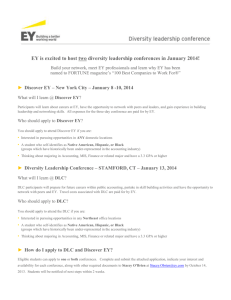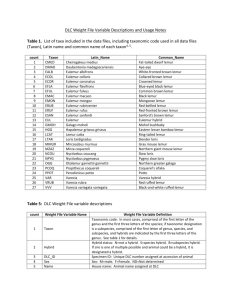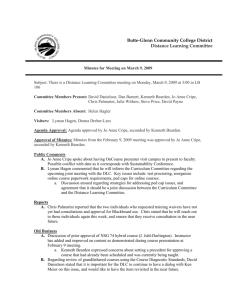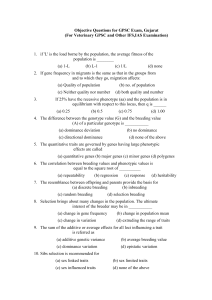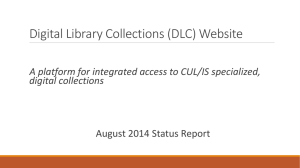README.
advertisement
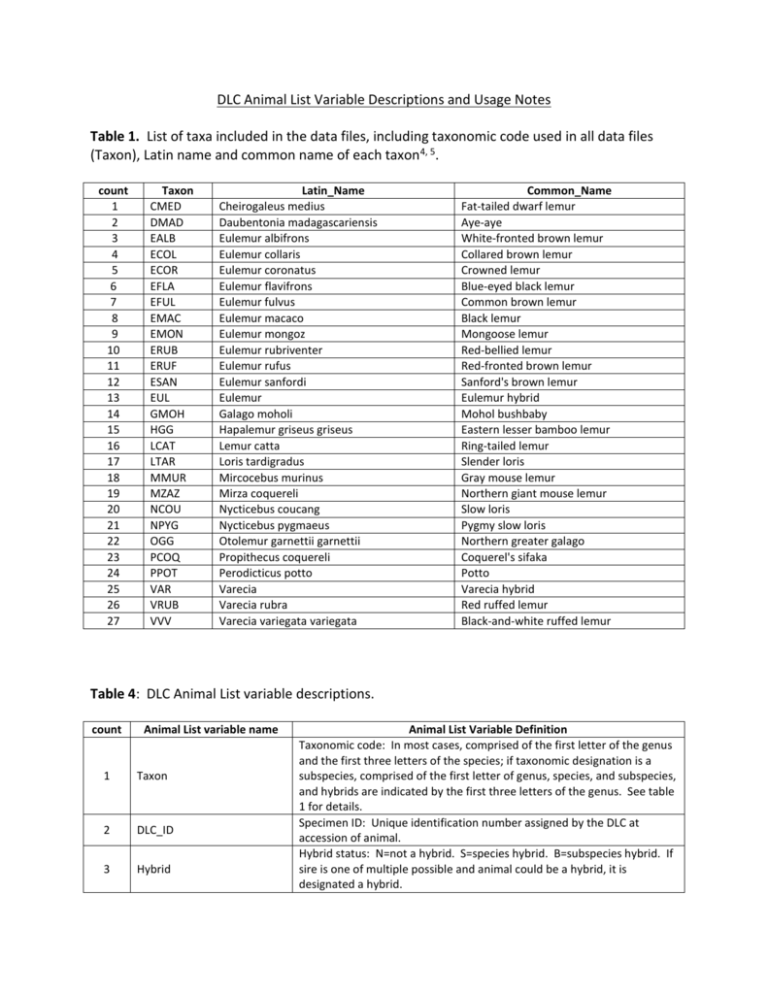
DLC Animal List Variable Descriptions and Usage Notes Table 1. List of taxa included in the data files, including taxonomic code used in all data files (Taxon), Latin name and common name of each taxon4, 5. count 1 2 3 4 5 6 7 8 9 10 11 12 13 14 15 16 17 18 19 20 21 22 23 24 25 26 27 Taxon CMED DMAD EALB ECOL ECOR EFLA EFUL EMAC EMON ERUB ERUF ESAN EUL GMOH HGG LCAT LTAR MMUR MZAZ NCOU NPYG OGG PCOQ PPOT VAR VRUB VVV Latin_Name Cheirogaleus medius Daubentonia madagascariensis Eulemur albifrons Eulemur collaris Eulemur coronatus Eulemur flavifrons Eulemur fulvus Eulemur macaco Eulemur mongoz Eulemur rubriventer Eulemur rufus Eulemur sanfordi Eulemur Galago moholi Hapalemur griseus griseus Lemur catta Loris tardigradus Mircocebus murinus Mirza coquereli Nycticebus coucang Nycticebus pygmaeus Otolemur garnettii garnettii Propithecus coquereli Perodicticus potto Varecia Varecia rubra Varecia variegata variegata Common_Name Fat-tailed dwarf lemur Aye-aye White-fronted brown lemur Collared brown lemur Crowned lemur Blue-eyed black lemur Common brown lemur Black lemur Mongoose lemur Red-bellied lemur Red-fronted brown lemur Sanford's brown lemur Eulemur hybrid Mohol bushbaby Eastern lesser bamboo lemur Ring-tailed lemur Slender loris Gray mouse lemur Northern giant mouse lemur Slow loris Pygmy slow loris Northern greater galago Coquerel's sifaka Potto Varecia hybrid Red ruffed lemur Black-and-white ruffed lemur Table 4: DLC Animal List variable descriptions. count Animal List variable name 1 Taxon 2 DLC_ID 3 Hybrid Animal List Variable Definition Taxonomic code: In most cases, comprised of the first letter of the genus and the first three letters of the species; if taxonomic designation is a subspecies, comprised of the first letter of genus, species, and subspecies, and hybrids are indicated by the first three letters of the genus. See table 1 for details. Specimen ID: Unique identification number assigned by the DLC at accession of animal. Hybrid status: N=not a hybrid. S=species hybrid. B=subspecies hybrid. If sire is one of multiple possible and animal could be a hybrid, it is designated a hybrid. 4 5 Sex Name 6 Current_Resident 7 StudBook 8 DOB 9 Birth_Month 10 Estimated_DOB 11 Birth_Type 12 Birth_Institution 13 Litter_Size 14 Expected_Gestation_d 15 16 Estimated_Concep Concep_Month 17 Dam_ID 18 19 Dam_Name Dam_Taxon 20 Dam_DOB 21 Dam_AgeAtConcep_y 22 Sire_ID 23 24 Sire_Name Sire_Taxon 25 Sire_DOB 26 Sire_AgeAtConcep_y 27 DOD 28 AgeAtDeath_y Sex: M=male. F=Female. ND=Not determined House name: Animal name assigned at DLC Resident status: Whether or not the animal currently lives in the DLC colony. Studbook Number: Regional or global unique ID among captive individuals of that species; assigned by AZA studbook keeper. Not all individuals have studbook numbers in this data record. Date of Birth: DOB is an exact date unless there is an entry in the "Estimated_DOB" field. Month of birth: Identified from DOB Date of Birth estimate: Whether or not the date of birth is an estimate. Y=estimated to the nearest year, M to the nearest month, and D to the nearest day. If there is a number after the letter code, that indicates to the Nth value of the code. U=unknown. If there is no entry in this field, DOB is not an estimate. Type of birth: Whether the animal was captive-born (CB), wild-born (WB) or of unknown birth type (UNK) Birth institution: Name or ISIS abbreviation of institution where animal was born. Duke Prim=DLC. For wild caught animals, birth institution = country of origin, if known. Litter size: Number of infants in the litter the focal animal was born into (including focal animal). Only indicated where verifiable (born at DLC). A missing value indicates that the litter size is unknown. Expected gestation length: Values based on DLC observations and reports from the literature, in days Date of estimated conception: Calculated as (DOB-Expected_Gestation) Month of estimated conception: Identified from Estimated_Concep Specimen ID of female parent. DLC unique ID preferred if there is one. Local ID of another ISIS-reporting institution if known and no DLC number exists. “Wild” indicates dam of wild-caught individual. "Unk" or no data indicates dam is unknown. House name of female parent (at DLC) Taxon of female parent: Based on taxonomic code described above Date of birth of female parent: If female parent is wild caught or of unknown origin, this date is an estimate. Estimated age of female parent at conception of focal animal: in years ((Estimated_Concep-Dam_DOB)/365) Specimen ID of male parent: DLC number preferred if there is one. Local ID of another ISIS-reporting institution if known and no DLC number exists. “Wild” indicates sire of wild-caught individual. “MULT” indicates multiple possible sires. A following number indicates number of possibilities (e.g. MULT2). “Unk” or no data indicates unknown sire and may include cases of multiple possible sires. House name of male parent (at DLC) Taxon of male parent: Based on taxonomic code described above Date of birth of male parent: If male parent is wild caught or of unknown origin, this date is an estimate. Estimated age of male parent at conception of focal animal: in years ((Estimated_Concep-Dam_DOB)/365) Date of death: Verified date an animal died. Missing indicates animal is either alive or status is unknown Age at death: Age of animal at verifiable date of death, in years ((DOD- 29 AgeOfLiving_y 30 AgeLastVerified_y 31 AgeMax_LiveOrDead_y 32 N_known_offspring DOD)/365). Missing indicates animal is either alive or status is unknown. Age if alive: Verifiable living age of DLC-owned animals and/or current residents at DLC on loan, in years as of the date the datafile was updated ((date of last update-DOB)/365). Missing indicates animal is either dead or status is unknown. Last verifiable age: Age of animal at most recent date a non-DLC owned, non-current resident animal was verifiably alive, in years. Dates were obtained from ISIS as entered by other institutions (dates of live weight or animal transfer) or via direct communication from other animal facilities. ((DateLastVerified-DOB)/365). Missing indicates animal is known to be dead or alive. Maximum age: The animal's age from any of the three age categories (each individual must have a value in one of the three) indicating the maximum age the animal could have achieved as of the date the datafile was updated. Number of offspring: Number of offspring the individual is known to have produced. There may be additional offspring for this individual if they were born at another institution or if this individual is a possible, rather than known, parent. Construction of Strepsirrhine Life History Table The DLC Life History Table (Table 2) is constructed entirely from variables available in the two associated raw data files provided in this data paper (DLC Animal List and DLC Weight File). Each variable presented in the life history table is named using five terms in the format of Category_Measurement_Group_Variable_Units. The first term is the identifier to indicate a data category as follows: variables relating to sample size or animal counts have an S. Variables relating to reproduction begin with an R. Those relating to body mass have an M, and those relating to longevity and mortality an L. Finally, any variables not relating to those categories begin with an O (other). The second term in the name is the type of measurement, for example N, Mean, Max, Min, Peak or Pct. The third term identifies the group the variable is assessed for: all individuals (All), males only (M) females only (F), individuals of undetermined sex (ND), female parent (Dam), or male parent (Sire). The grouping term is omitted if inappropriate, as is the case for some variables relating to litter size, birth, and breeding season. These three qualifiers are followed by the variable core (e.g. AdultWeight, LitterSize, AgeAtDeath, etc.). Finally a unit of measure is added to the end if needed (y=years, day=days, g=grams). All life history table variable definitions are shown in Table 3, and justification and explanation of calculations are given below. Decisions regarding which individuals and data to include in each summary calculation were guided by our intimate knowledge of captive management and breeding practices, some of which could make certain subsets of data unreliable, and we urge users to consider these limitations as described; additional cautions are given in the “Usage Notes” section below. Should users opt to implement different strategies for generating species summaries, however, they need only to refer to the accompanying data files for the source information. In addition to the reference table provided in this data descriptor, an analytic version of the table is available for direct use in statistical software (see “Data Records” below). Category S: Animal number/sample size variables Numbers of animals in various categories were counted to provide sample sizes for specific summary variables presented in the life history table, as well as to provide criteria that researchers can use to determine which species and/or subsets of data may be appropriate for use in other projects based on sample size requirements. Number of individuals in the historic DLC colony includes animals born at the DLC, wild-born animals, animals from other institutions that transferred into the colony at any time in the DLC history, and DLC-owned animals at other institutions (i.e. all animals for which we have data). Numbers of animals in the current DLC colony reflect animals currently living on site at the DLC who are potentially available for research use. Male and female individuals are sexed at birth or acquisition, and in cases where infants were stillborn or died very young and not sexed, sex is designated as ND (not determined). Captive-born (CB) animals were born at the DLC or at another captive facility and have known dates of birth. Wild-born (WB) animals were imported by the DLC or by another institution from the animal’s country of origin and have estimated dates of birth. For some individuals, origin is unknown (U) and they too have estimated dates of birth. The age of most wild-born animals and animals of unknown origin was estimated on arrival by experienced staff and based on physical appearance, tooth wear, and other morphological characteristics. If the animal’s age at capture was estimated and documented, the date of birth is assigned as follows: for seasonally breeding species, the first day of the middle month of breeding season in the country of origin in the estimated year of birth is used; for non-seasonal breeders, the month and day of acquisition is used with the estimated year of birth. In some cases an age estimate was not documented and the animal was merely described as “adult”. In such cases, the animal was assigned the age equal to the minimum dam age at reproduction for that species (see discussion under “reproductive variables” below) and so any ages calculated for that animal are a minimum. As such, these animals are included in calculations involving the maximum of a variable (the estimated age of an animal cannot be artificially older than the true age) but not the minimum of a variable (estimated age of an animal could be artificially younger than the true age). Minimum dam age at conception was used in all determinations of adult age rather than using the dam value for females and the sire value for males. This decision was based on factors of captive breeding management wherein dams are more reliably bred at earliest ages to increase numbers of breeding animals in the colony, but they may be paired with more experienced sires to increase chances of breeding success, making the sire minimum age at conception potentially less reliably accurate as an indicator of adult status than dam minimum age at conception for some species with relatively few breeding sires. Category R: Reproductive variables Variables relating to conception (e.g. breeding season, age at conception) use an expected date of conception that is calculated by subtracting gestation time from infant date of birth. In an attempt to control for premature births, for which date of conception would be erroneously estimated to be earlier than the true date, infants who did not survive at least one day were excluded from calculations involving date of conception thus excluding any infants who were stillborn due to prematurity. Expected gestation time is assigned for each species based on DLC cases where copulation was observed and documented and the number of days to subsequent infant birth counted. Gestation time ranges take into account both these observations and reports of gestation time in wild populations 5, 6, 7, 8, 9, 10, 11. Because much of the information relating to breeding events is still embedded in descriptive records, gestation time variables are a summary rather than a true calculation, with “Expected_Gestation_day” identified as the most commonly used at the DLC for each species, which in most cases lies on the lower end of the gestation range. More thorough analyses of descriptive DLC breeding records may result in fine-tuning of these values in the future, but we have confidence that these are valid estimates because their use with observed breeding behaviors in the current colony predicts birth to within a few days. Each taxon is characterized as a seasonal (S) or a non-seasonal (NS) breeding species. Birth and Breeding season peaks are based only on infants born at the DLC with known dates of birth and are only calculated for seasonally breeding species. Nonseasonally breeding species show a “0” for these variables. As discussed above, date of conception is calculated by subtracting gestation time from date of birth; date of birth is an exact value, but date of conception is an estimate. We therefore assess seasonal values using month, rather than day, of the event. Peak birth/breeding month is calculated by identifying the month in which the most events occurred for each species; an event is defined here as the birth or conception of a litter, not an individual. Peak birth/breeding season includes sequential months on either side where a) at least one third as many events took place or b) at least 20% of total number of events took place. These constraints were imposed to identify the peak, not necessarily the entire, breeding season. Importantly, their implementation systematically eliminates small tails that may artificially lengthen the true breeding season, especially for species where overall number of births was low and a single early or late pregnancy could extend it. Minimum ages at reproduction were calculated using only individuals with known dates of birth (i.e. no wild-born animals or animals of unknown origin). Maximum ages at reproduction may include individuals with estimated dates of birth (see discussion above). Litter size variables are based only on animals born at the DLC but do include all DLC births (including infants that did not survive 1 day), and include the average, most common, maximum and minimum litter sizes observed for each species, as well as the frequency of the most common litter size. Birth sex ratio of male to female DLC births is calculated for each taxon. Only DLC births are used because animals brought in from the wild or from other institutions may be selected based on programmatic needs (e.g. wild founders were typically imported as male-female pairs) and may mask the underlying birth sex ratio. Category L: Longevity variables Maximum age is determined by the age of the oldest individual recorded, living or dead, and includes animals with estimated dates of birth as described above. Longevity was assessed using a proportional hazards model after exclusion of young infant deaths (death prior to 30 days of age) and censoring of living animals and those with uncertain status. Median longevity was derived from the average age of the nearest uncensored values above and below 50% survivorship after each was weighted by distance from the 0.5 midpoint [((Upper age – (Upper age * distance from midpoint)) + ((Lower age + (Lower age * distance from midpoint)))/2]. Infant mortality percentage is calculated as the percentage of infants born at the DLC who died at less than 30 days of age. Infant mortality here does include stillbirths. More thorough analyses of DLC descriptive records will eventually allow us to differentiate between rates of stillbirth and rates of live infant mortality. Category M: Body mass variables To eliminate artificially low or high values from unviable stillborn individuals, mean, maximum and minimum neonatal weight calculations include only individuals that survived at least 1 day. Neonatal body mass variables include measurements taken on day 0 (day of birth) or day 1. If both have been recorded for a single individual, the average is used to represent that individual. Inclusion of day 1 weights dramatically increases sample sizes for some species, and individuals variably gain, maintain or lose weight on day 1, so we feel that inclusion of both measurements will yield the most accurate species values. Species values are the mean, maximum, and minimum weights across all individuals of that species. Adult body mass calculations include all weights obtained after an individual reached twice the minimum dam age at reproduction for the species. This age cutoff was enforced in order to ensure that adult body mass values are not artificially lowered due to the inclusion of weights taken during the late “near-adult body size” growth period. An additional category of young-adult body mass was created and includes weights taken when an animal was between minimum age at reproduction and twice the minimum age at reproduction. A comparison of the two categories reveals that young adult averages are indeed lower than the adult averages for 24 of 27 species, indicating that animals of most species are still growing, albeit slowly, during this period. Finally, in order to ensure that weights from wild-caught juveniles of non-exact age did not affect age-based analyses, weights from wild-caught animals at age estimates younger than dam age at first reproduction were excluded. Mean adult and young adult weights are calculated as follows: weights taken within 60 days of death were excluded, as were weights from pregnant females. If multiple weights were obtained for an individual in a single month, those weights were averaged so as not to bias results from periods of frequent weighing (e.g. for research projects or due to health concerns). The average body weight for each individual was then generated using the mean across all monthly averages for that animal. A mean for all individuals of a species was then calculated from these individual averages. Animals whose average weight was more than two standard deviations above the mean were considered obese (adult=46 of 1358 individuals; young adult=32 of 932 individuals), and removed from final analyses so as not to skew species means upward12, 13. The remaining (non-obese) individual means were averaged by species, and by sex where indicated. Maximum and minimum body mass values were obtained from the highest and lowest of these individual averages. Category O: Other variables Activity type – nocturnal or diurnal – is indicated for each species (N and D respectively). Numbers of individuals for which biological samples are available in the DLC collection is also shown for each taxon. Biological samples are opportunistically banked, and types of samples available include blood, serum, cadavers, ultra-cold tissues from major and obscure organs, RNA-later infused tissues, and formalin fixed samples. The number and type of samples available for any individual is wildly variable, with some individuals having all of the above sample types available, and others represented by as little as a single eyeball. See below under “usage notes/additional data….” for details of how to obtain more information about samples specific to a species, individual, or sample type. Usage Notes Wild vs. captive populations All data presented are from captive individuals and may not necessarily be representative of wild population values, particularly for some variables. For example, we expect that longevity in captive populations will exceed that of wild populations in most cases due to lack of predation and access to veterinary care in the former. Reproductive variables that are affected by variation in resource availability may also differ as captive populations have continual access to species-appropriate diets with no seasonal or yearly scarcity. Similarly, body mass may be higher in captive populations because they are never resource-challenged. In some cases, the degree to which captive and wild data concur will vary by species and will be affected by sample sizes and methods of analysis. We therefore warn against using these captive-derived values to directly assess life history variables in wild populations, but suggest that researchers may be able to use them as relative indicators of life history variables in wild populations with caution. For example, a comparison of body mass variables in this dataset to those for wild populations extracted from the literature for 20 lemur species14 reveals that across all species, average adult body masses at the DLC are 19% higher than averages for wild populations summarized from the literature; half of the species are fairly comparable to wild body mass (DLC animals are -1% to +11% heavier), with the other half showing greater discrepancies (DLC animals are +18% to +52% heavier). However, there are some factors that may explain some of the variability. First, in the captive data, we differentiate between adults and young adults, which would have a tendency to increase the DLC average compared to wild estimates from the literature if those contain many young adult individuals. Second, 6 of the 10 more discrepant species are flagged as having “large variation in measurements relative to mean body size” in Table 1 of Taylor and Schwitzer14, indicating that those averages may vary seasonally, by population or by study. Finally, the most discrepant species (Eful at 52%) is so distinct from the DLC values that we suspect the possibility that two different subspecies or quite distinct populations have been measured. If all of the cases of questionable data are excluded, the DLC animals are on average 12% heavier than wild populations. Thus, while a fine scale assessment of body size in wild populations cannot be derived from the DLC data, a comparison one species relative to another may provide insightful results. Breeding seasonality All breeding and birth season data are for the captive colony in North America, and are seasonally opposite of breeding and birth seasons in Madagascar, which is home to all wild lemur populations. Timing and success of reproduction There are some analyses that should not be conducted with these data because of factors associated with captive breeding management. Breeding is very strictly managed, so individual ages at reproduction do not give a true indication of a) individual variation in minimum, maximum, or mean age at reproduction or b) inter-birth interval. If a female does not conceive until well into adulthood, it is much more likely that she wasn’t allowed to breed than that she wasn’t able to breed. Because the sample sizes are large in most cases, we do feel that species values for the minimum and maximum ages at reproduction are reliable and as such, they are provided in the life history table. In the DLC Animal List data file, there is a variable named “N_Known_Offspring” that indicates the number of offspring in our records for that the individual is known to have parented. This should not be taken as a measure of relative reproductive success. In other words, dams with more known offspring are not necessarily more reproductively fit than those with fewer or no known offspring, and it may simply be that the former were given more reproductive opportunities based on management strategies. In addition, some of the offspring counts may be underestimates because a) some individuals may have had offspring at other institutions that are not accounted for in our records, and b) in cases where there are multiple possible sires of an offspring, that offspring is not counted for any of the potential sires. Longevity In some cases with small numbers of uncensored data points, a median longevity could not be calculated because the proportional hazards curve never drops below 50% survivorship. We see this for the aye-aye females, where the oldest female death is still young relative to other data points. As older aye-aye females die over time, these values will be able to be calculated. Body mass: seasonal variation The body mass summaries in the life history table are based on all weights, regardless of season in which they are taken. There is seasonal weight variation in some species, and it is particularly striking in the small nocturnal mouse and dwarf lemurs, where average summer weights (Mmur: Apr-Sept; Cmed: May-Oct) are significantly lower than the average winter weights (Mmur: Oct-March; Cmed: Nov-Apr). If the data are being used for a project that is sensitive to this, users should parcel weight data from the Weight File based on the “MonthOfWeight” variable and use subsets accordingly. Hybrid animals The known Eulemur hybrids are a mix of between two and five of the following species: Ealb, Ecol, Eful, Eruf, Esan, and Emac. Varecia hybrids are a mix of Vrub and Vvv. Hybrid status is entered in ARKS and in cases where hybrid status is unknown, data output indicates a hybrid status of “N” (not a hybrid). There are 16 animals identified taxonomically as Eulemur hybrids that are potentially not hybrids because at least one potential sire is of a species that matches the remainder of the animal’s ancestry (DLC_ID’s 5801, 5802, 5933, 5934, 6087, 5553, 5554, 1574, 2513, 2550, 2551, 3527, 3561, 1554, 6212, 2566). These animals are identifiable in the output because their taxonomic code (Eul) indicates a hybrid animal, but their hybrid status is “N”. ZIMS can produce output indicating “hybrid status unknown”, so these entries will be adjusted once the migration from ARKS to ZIMS is complete. Additional data, updates, and project information Interested users may obtain additional access to these data files and future updated versions of data or other DLC project information as follows: 1) Direct download. As outlined above, data records are available in Dryad. Users may also download data files by connecting to the Duke Lemur Center web site (http://lemur.duke.edu/discover/for-researchers/) and navigating to the ”historic animal data” page where they will be guided through a brief registration (free) and then be connected to the download page. There are no costs associated with these data downloads. The download page is where future updated versions of the data described here will reside, and updates will also be deposited in Dryad on a yearly basis. 2) Specified data file requests. To inquire about or request a specific dataset that may include information not presented here, please contact corresponding author and DLC data manager, Sarah Zehr, at sarah.zehr@duke.edu. There is currently no cost for such requests, but fees may be implemented in the future to offset the cost of database maintenance. 3) Live animal or biological sample projects. For more information about use of the live DLC colony or acquisition of biological samples, please go to the Duke Lemur Center web site (http://lemur.duke.edu)and navigate to the research page to find more information about these classes of research, as well as contact information for the DLC Research Manager who oversees them. There are fees associated with both live animal use and biological sample purchase.
